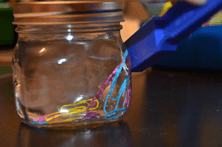Magnets to Guide Stem Cells Through the Body

Researchers at Emory University have devised a new method for directing stem cells to the target areas in the body. This new method will prove to be helpful in treating various conditions like heart and vascular diseases by using stem cell therapy methods.
The research has been conducted by a team led by Dr. W. Robert Taylor of Emory University School of Medicine and Dr. Gang Bao of both Georgia Tech and Emory University. The stem cells fed with magnetized iron oxide nanoparticles were intravenously injected into a mouse and then directed to a particular location with the help of magnets.
The scientists have made use of mesenchymal stem cells that can be easily extracted from adult tissues like bone marrow or fat. These cells secrete nourishing and anti inflammatory factors useful for treating cardiovascular and autoimmune disorders. They can differentiate into bone, fat and cartilage cells.
The iron oxide nanoparticles fed into the cells have a polyethylene glycol (PEG) coating to prevent damage to cells. These PEG coated iron oxide nanoparticles were inserted into the stem cells using magnetic field. The iron content in loaded cells is measured. Ideally, each loaded stem cell should have absorbed around 1.5 million nanoparticles. These nanoparticles concentrate around the liposomes inside these cells and they stay inside for at least a week before the cells get rid of it.
The nanoparticle loaded stem cells were then tested for their capability of being moved in cultures and inside living organisms using magnets. They were tested upon mice by injecting these loaded cells to the tail, with a bar magnet placed on a portion of the tail nearby to the injection site. These loaded stem cells, also tagged with fluorescent dye for tracking its movement inside the body were found to remain concentrated in the tail itself, which otherwise would have deposited themselves in the lungs or liver of the mouse.
This experiment exhibits the possibility of effectively guiding stem cells using magnetic field. Further research will now be focused on developing therapeutic applications in animal models to direct the stem cells precisely to the site of interest in need of repair or regeneration and its use in humans.
Source:Emory University

